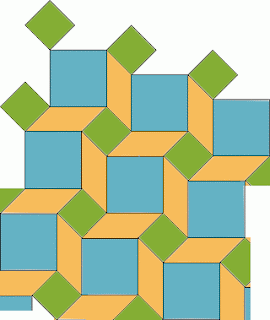Today I have a geometry problem for you.
Just yesterday I showed you a proportion problem and its solution.
(I want to insert a note here, especially for parents reading this.
Don't feel that you always need to use the problems I present here with your students. Instead, as a homeschooling parent, consider them part of your "math teacher training" that you never got. Reading through problems and their solutions will help you become a better math teacher. Consider yourself an apprentice observing a master completing a task, in this case mathematics problem solving.
It just takes you a minute or two to read this, think it through, try it - and understand (I hope). Your students' or child's book will have similar problems later on when it's time for geometry studies, but if you read these that I present, you will have learned more and can better tackle those problems at that time.)
OK, here we go. Look at the tiling below. Here you can see the tiling in real life, on a floor in Germany.

The original problem asks you about the area of the small square and of the parallelogram, given that the area of the large square is 1 square meter and that the ANGLE between the large and the small square is 45°.
But, I simply ask you (or your student) to DRAW this picture. Just take out blank paper, a ruler, and a protractor, and DRAW it. Can you draw it exactly how it is in my picture?
Solution:
This tiling will work (it will tile the plane), no matter what the size of the "little square". So, it is NOT possible for you to draw it exactly like I did, unless you knew something more about the side lengths.
Here's an example where use the same information, but made the small square smaller than in the previous picture:

To solve the original problem of finding the area of the little square and of the parallelogram, one would need some more information, such as a side length or ratio of side lengths.
SO, all in all, it's a problem with incomplete information to solve it...
However, someone suggested in the comments a solution to the original problem where we assume that the parallelogram is cut into two right triangles by its diagonal. With that additional information, the area calculation would be solvable.
(BTW, For my first picture, I used golden ratio as the ratio of the side of the large square to the side of the small square.)

No comments:
Post a Comment